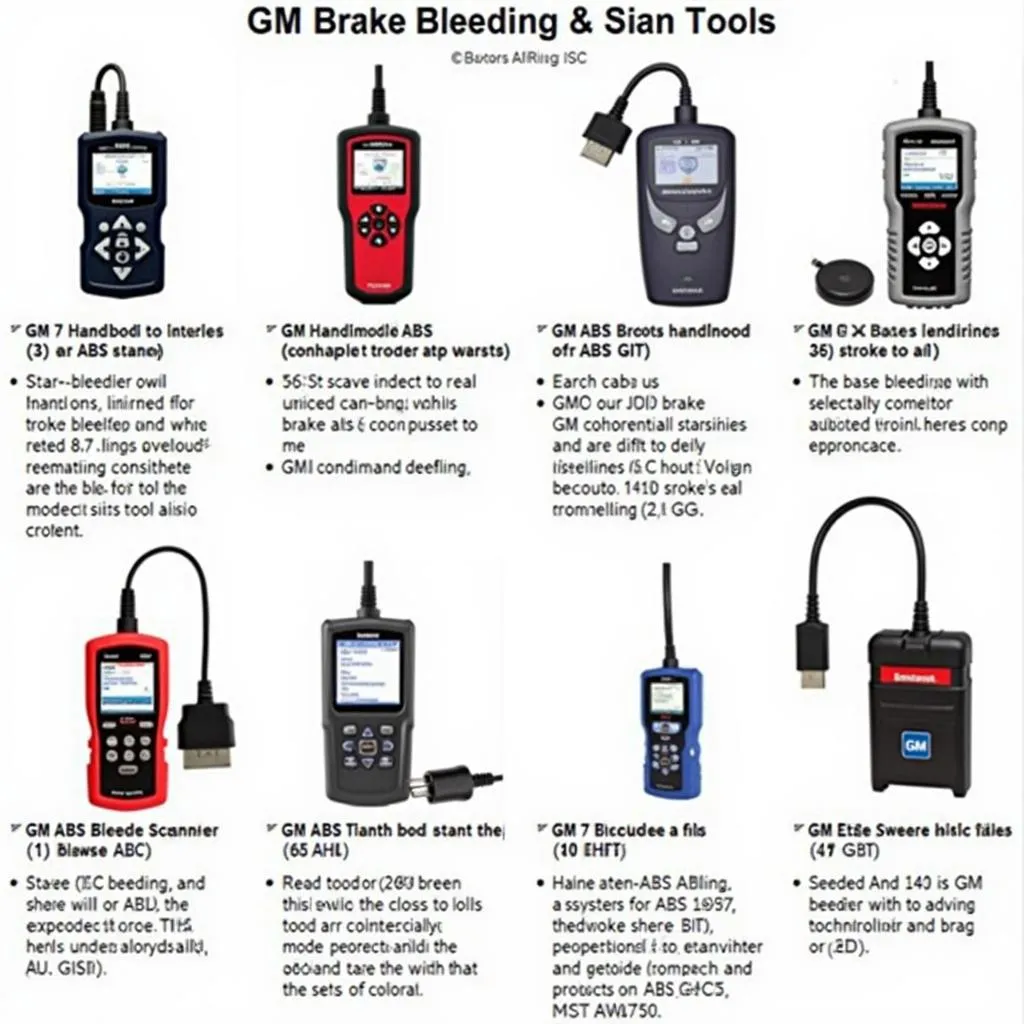Imagine this: you’re driving down a scenic highway in your trusty Chevrolet Silverado. Suddenly, you feel a spongy brake pedal, and your ABS light pops up on the dashboard. Your heart skips a beat – something’s not right! This, my friend, is when you need to think about brake bleeding, and specifically, a GM ABS brake bleeding scan tool.
Understanding the Importance of a GM ABS Brake Bleeding Scan Tool
Why all the fuss about a scan tool, you ask? Well, let’s break it down.
From a mechanic’s perspective, a GM ABS brake bleeding scan tool is like having X-ray vision into your vehicle’s braking system. It allows us to diagnose issues quickly and efficiently, saving you valuable time and money in the long run.
Technically speaking, modern GM vehicles, much like many European cars with sophisticated electronics, rely on a complex ABS module to ensure optimal braking performance. When air gets trapped in this system, it disrupts the hydraulic pressure needed for effective braking. This is where the scan tool comes in, allowing us to activate the ABS module and bleed the brakes properly, ensuring that every nook and cranny of the system is free of air.
This isn’t just about mechanics and technology; it’s about your safety and peace of mind. A properly bled ABS system translates to shorter stopping distances and improved control, especially in emergency situations.
 Mechanic using a GM ABS brake bleeding scan tool on a Chevrolet Silverado
Mechanic using a GM ABS brake bleeding scan tool on a Chevrolet Silverado
Demystifying the Need: When Do You Need a Scan Tool for ABS Brake Bleeding?
You might be wondering, “Do I always need a scan tool to bleed my GM’s brakes?” The answer, unfortunately, isn’t always straightforward.
For older GM models, you could sometimes get away with the traditional method of bleeding brakes manually. However, with the advent of electronically controlled ABS systems, the game changed. Now, many newer GM vehicles require a scan tool to cycle the ABS module and ensure a complete and effective bleed.
Here are some telltale signs that you might need a GM ABS brake bleeding scan tool:
- The brake pedal feels spongy or goes too far down. This could indicate air in the system.
- Your ABS light stays illuminated on the dashboard. This often signals a problem within the ABS module, which might require a scan tool to diagnose and address.
- You’ve recently had work done on your braking system, such as replacing a caliper or brake lines. Any time you open the brake system, there’s a risk of introducing air, requiring a proper bleed, often with a scan tool.
Navigating the Options: Choosing the Right GM ABS Brake Bleeding Scan Tool
Now, let’s talk about the tools themselves. You’ll find a range of scan tools on the market, from basic code readers to advanced professional-grade systems.
For DIY enthusiasts, a good quality OBD-II scanner with ABS bleeding capabilities might suffice for basic tasks. However, if you’re dealing with a particularly stubborn ABS issue or own a newer GM model, investing in a professional-grade scan tool is often a wise decision. These tools offer more advanced features, including bi-directional control, which allows you to command the ABS module directly.
 A variety of GM ABS brake bleeding scan tools on display
A variety of GM ABS brake bleeding scan tools on display
Here are some key features to look for in a GM ABS brake bleeding scan tool:
- Compatibility: Ensure the tool is compatible with your specific GM make, model, and year.
- ABS Bleeding Function: This is crucial for activating the ABS module during the bleeding process.
- Bi-Directional Control (Optional): This allows for more advanced diagnostics and control over the ABS system.
- User-friendliness: Opt for a tool with a clear interface and easy-to-understand instructions.
Beyond the Scan Tool: Additional Tips for Successful Brake Bleeding
While a GM ABS brake bleeding scan tool is a powerful ally, remember that it’s just one piece of the puzzle.
Here are some additional tips to ensure a successful brake bleeding process:
- Consult your vehicle’s repair manual: This will provide specific instructions and bleeding sequences for your model.
- Use high-quality brake fluid: Refer to your owner’s manual for the recommended type and DOT rating.
- Work with a partner: Having an extra set of hands to help depress the brake pedal while you bleed the lines can make the process much smoother.
- Don’t rush: Take your time and follow the bleeding sequence meticulously.
Remember, “An ounce of prevention is worth a pound of cure.” Regularly inspecting your braking system and addressing any issues promptly can save you from headaches and potentially dangerous situations down the road.
Seeking Expert Help: When to Call in the Pros
While tackling DIY projects can be rewarding, some tasks are best left to the experts. If you’re uncomfortable working with your vehicle’s braking system or encounter persistent issues, don’t hesitate to seek professional help.
A qualified mechanic with the right tools and expertise can diagnose and repair any brake-related problems efficiently and safely, giving you peace of mind on the road.
Exploring Further: Common Questions and Related Topics
You might also be interested in these frequently asked questions:
- Can I bleed GMC ABS brakes without a scan tool? (link to https://diagxcar.com/bleeding-gmc-abs-without-scan-tool/)
- What are the best scan tools for bleeding ABS brakes on GMC vehicles? (link to https://diagxcar.com/scan-tool-for-abs-brake-bleeding/)
- How much does it cost to bleed ABS brakes at a mechanic?
Remember, knowledge is power when it comes to car maintenance.
Need Help? We’re Just a Message Away!
For expert advice on diagnostic tools and software installations, our team of automotive specialists is here to assist you 24/7. Contact us via WhatsApp at +84767531508. We’re always happy to help you keep your GM running smoothly and safely.


